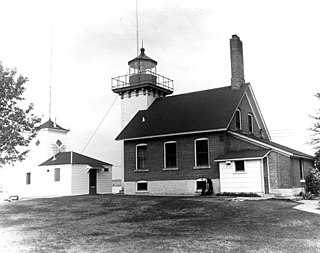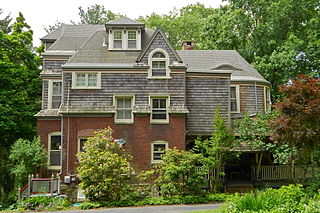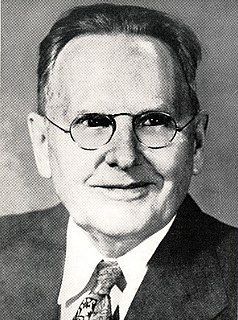
Belle of Louisville is a steamboat owned and operated by the city of Louisville, Kentucky, and moored at its downtown wharf next to the Riverfront Plaza/Belvedere during its annual operational period. Originally named Idlewild, she was built by James Rees & Sons Company in Pittsburgh, Pennsylvania, for the West Memphis Packet Company in 1914 and was first put into service on the Allegheny River. Constructed with an all-steel superstructure and asphalt main deck, the steamboat is said to hold the all-time record in her class for miles traveled, years in operation, and places visited. Belle of Louisville's offices are aboard Mayor Andrew Broaddus, also a National Historic Landmark.

This is a list of sites in Minnesota which are included in the National Register of Historic Places. There are more than 1,700 properties and historic districts listed on the NRHP; each of Minnesota's 87 counties has at least 2 listings. Twenty-two sites are also National Historic Landmarks.

The Sherwood Point lighthouse is a lighthouse located near Idlewild in Door County, Wisconsin, United States.

The TWA Flight Center, also known as the Trans World Flight Center, is an airport terminal and hotel complex at New York City's John F. Kennedy International Airport (JFK). The original terminal building, or head house, operated as a terminal from 1962 to 2002 and was adaptively repurposed in 2017 as part of the TWA Hotel. The head house is partially encircled by a replacement terminal building completed in 2008, as well as by the hotel buildings. The head house and replacement terminal collectively make up JetBlue's JFK operations and are known as Terminal 5 or T5.

Winks Panorama, also known as Winks Lodge, was a hotel near Pinecliffe, Colorado catering to African-American tourists during the early and middle 20th century. The lodge was built in the Lincoln Hills Country Club, which was at the time the only African-American resort in the western United States. The Lincoln Hills club was organized in 1922, selling lots with payments as low as $5.00 down and $5.00 per month. The lodge was built by Obrey Wendell "Winks" Hamlet in 1928. Hamlet had been involved in the original club project, and had been assembling land for a lodge since 1925. The Wall Street Crash of 1929 caused many lots in Lincoln Hills to be abandoned, but Hamlet promoted the lodge nationally through advertisements in Ebony and attracted a clientele from the eastern United States.

The Michigan Bell and Western Electric Warehouse is a former commercial warehouse building located at 882 Oakman Boulevard in Detroit, Michigan. It was listed on the National Register of Historic Places in 2009. It is now known as the NSO Bell Building.

Ormonde (1885–88) is a Shingle Style country house built on the eastern shore of Cazenovia Lake in Cazenovia, New York. It was designed by architect Frank Furness for George R. Preston, a New Orleans banker who settled in Philadelphia, Pennsylvania.

The Charles J. and Ingrid V. (Frendberg) Koebel House is a private house located at 203 Cloverly Road in Grosse Pointe Farms. It was listed on the National Register of Historic Places in 2009.

The I.O.O.F. – Paris Fair Building in Hood River, Oregon was built in 1906, with Early Commercial architecture. Also known as Idlewild Lodge No. 107, Odd Fellow's Hall, and Paris Fair Department Store, it served historically as a department store and as an International Order of Odd Fellows meeting hall. It was listed on the National Register of Historic Places in 1990.

Idlewild is a historic plantation house and historic district just east of Talladega, Alabama, United States. The property was added to the Alabama Register of Landmarks and Heritage and the National Register of Historic Places in 1993, due to its architectural significance.

David S. Castle was an architect in Texas.

Idlewild Presbyterian Church is a historic church located at 1750 Union Avenue in Midtown Memphis, Tennessee. Idlewild is a part of the Presbyterian Church (USA).

Idlewild is a historic building near Media, Pennsylvania, designed by the Victorian-era Philadelphia architect Frank Furness as a summer cottage for his family. He spent summers there until his death in 1912.

The California Building, located at 1000 Cowan Dr., Idlewild Park, in Reno, Nevada, is a historic building that was built by the state of California for the Transcontinental Highway Exposition of 1927.

Idlewild, also known as the Downman House, was a historic home located at Fredericksburg, Virginia. It was built in 1859; a fire in April 2003 destroyed most of the interior and collapsed the roof. It was a 2 1⁄2-story, Gothic Revival-style brick dwelling with an English basement and an irregular "T" shape with a center passage plan. The house was topped by a steep slate gable roof. Also on the property at present are three contributing brick dependencies and a contributing pet cemetery. During the American Civil War, Idlewild became a prominent landmark on May 4, 1863, during battle action related to the Chancellorsville campaign. On that evening Confederate General Robert E. Lee used the house as his headquarters, after being initially occupied that day by Federal troops of the Union Sixth Corps.

Dr. Franklin King House-Idlewild is a historic home located at Eden, Rockingham County, North Carolina. It was built in 1875, and is a 2 1/2-story, style frame dwelling with a 3 1/2-story tower. It combines elements of the Italianate, Queen Anne and Gothic Revival styles.

The Robert Chadwell House is a historic mansion in Madison, Tennessee, USA. It was built circa 1874. It was designed in the Italianate architectural style. It has been listed on the National Register of Historic Places since November 13, 1989.

The Maple Street–Clarks Avenue Historic District encompasses a historic 19th-century immigrant neighborhood of St. Johnsbury, Vermont. Located northwest of the downtown area on a sloping hillside, it consists of tenements and single-family houses built for Irish and French Canadian immigrants, sometimes grouped in ways that facilitated the support of large extended families. The district was listed on the National Register of Historic Places in 1994.

George Awsumb was a prominent Norwegian-American architect in the first half of the 20th Century. Awsumb defined architecture as “frozen music” designed for the “man on the street.” He was influenced by his early life, European travels, and prevailing architectural trends of his time. His eclectic, progressive portfolio included neoclassical, Gothic Revival, Prairie School, and International Style designs. Several buildings that Awsumb designed have been in continuous use in the American Midwest and South for over 100 years. In particular, Awsumb began a family architectural legacy that contributed to the progress and development of Memphis, Tennessee.




















